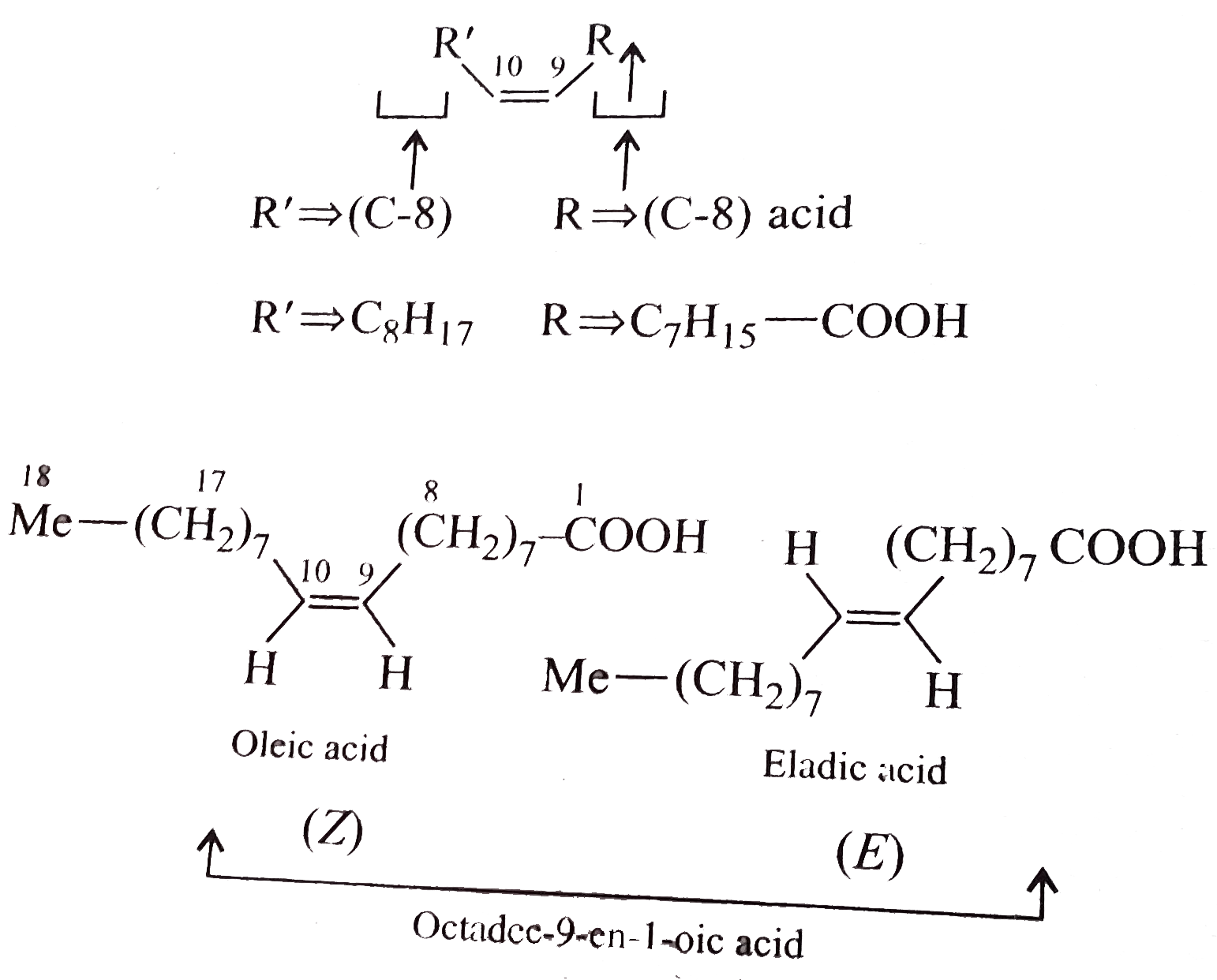Oleic acid and eladic acid are naturally occuring compounds which are isolated from various oils and fats.
Both diastereomers have one double bond at C−9. Oleic acid is cis and eladic acid is a trans isomer at C−9. Both have molecular formula C17H33COOH. Synthesise both from ethyne.
Write the structure of oleic and eladic acid.
(C=C) bond at C−9.
Total C atoms =(17±COOH)=18C

synthesis

Topper's Solved these Questions
- ALKYNESBOOK - CENGAGE CHEMISTRY ENGLISHCHAPTER - ALKYNESEXERCISE - Exercises (Linked Comprehension Type)
51 Videos
- ALKYNESBOOK - CENGAGE CHEMISTRY ENGLISHCHAPTER - ALKYNESEXERCISE - Exercises (Multiple Correct Answers Type)
25 Videos
- ALKYNESBOOK - CENGAGE CHEMISTRY ENGLISHCHAPTER - ALKYNESEXERCISE - Solved Examples
24 Videos
- ALKENES AND ALKADIENESBOOK - CENGAGE CHEMISTRY ENGLISHCHAPTER - ALKENES AND ALKADIENESEXERCISE - Single correct Answer
14 Videos
- APPENDIX - INORGANIC VOLUME 1BOOK - CENGAGE CHEMISTRY ENGLISHCHAPTER - APPENDIX - INORGANIC VOLUME 1EXERCISE - chapter-7 Single correct answer
1 Videos
Similar Questions
For the C3H4 (one triple bond) compound, write structural formulae and IUPAC names for all possible isomers having the number of double or triple bond as indicated:
View SolutionFor the following compounds, write structural formulas and IUPAC names for all possible isomers having the number of double or triple bond as indicated:
(a) C4H8(one double bond)
(b) C5H8 (one triple bond)
View Solution
Knowledge Check
Unsaturated fatty acids have
(a) high melting point
(b) one or more double bonds
(c) oleic acid
(d) palmitic acidAhigh melting pointBone or more double bondsColeic acidDpalmitic acid
Aspirin is a pain relieving drug.It is an 2-Alkanoyloxybenzoic acid derivative having molecular formula (C9H8O4) . How many sp2 carbon atom are present in aspirin.
View SolutionAnorganic compound (A) having molecular formula C9H10O forms an orange red precipitate (B) with 2,4-DNP reagent. Compound (A) gives a yellow precipitate (C) When heated in the presence of iodine and NaOH alongwith a colourless compound (D). (A) does not reduce Tollens' reagent or Fehling solution nor does it decolourise bromine water. On drastic oxidation of (A) with chromic acid, a carboxylic acid (E) of molecular formula C7H6O2 is formed. Deduce the structures of the organic compounds (A) to (E ).
View SolutionAnorganic compound (A) having molecular formula C9H10O forms an orange red precipitate (B) with 2,4-DNP reagent. Compound (A) gives a yellow precipitate (C) When heated in the presence of iodine and NaOH alongwith a colourless compound (D). (A) does not reduce Tollens' reagent or Fehling solution nor does it decolourise bromine water. On drastic oxidation of (A) with chromic acid, a carboxylic acid (E) of molecular formula C7H6O2 is formed. Deduce the structures of the organic compounds (A) to (E ).
View SolutionAnorganic compound (A) having molecular formula C9H10O forms an orange red precipitate (B) with 2,4-DNP reagent. Compound (A) gives a yellow precipitate (C) When heated in the presence of iodine and NaOH alongwith a colourless compound (D). (A) does not reduce Tollens' reagent or Fehling solution nor does it decolourise bromine water. On drastic oxidation of (A) with chromic acid, a carboxylic acid (E) of molecular formula C7H6O2 is formed. Deduce the structures of the organic compounds (A) to (E ).
View SolutionA compound (A) has molecular formula C5H9CI It does not react with bromine in CCI4 On treatment with a strong base it produces a single compound (B) (B) has a molecular formula C5H8 and reacts with Baeyer's reagent . Reductive ozonotysis of (B) produces a compound (C ) which has a molecular formula C5H8O2
formation of ( B) from (A) involves
View SolutionIn which of the following compounds does intramolecular H-bonding occure?
a. o-Nitro phenol
b, o-Cresol
c. o-Hydrox benzoic acid
View SolutionAn aromatic compound 'A' (Molecular formula C8H8O)) gives positive 2, 4-DNP test. It gives a yellow precipitate of compound 'B' on treatment with iodine and sodium hydroxide solution. Compound 'A' does not give Tollen's or Fehling's test. On drastic oxidation with potassium permanganate, it forms a carboxylic acid 'C' (Molecular formula C7H6O2), which is also formed along with the yellow compound in the above reaction. Identify A, B and C and write all the reactions involved.
View Solution
